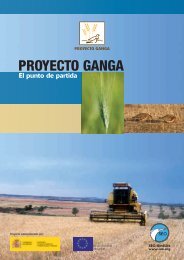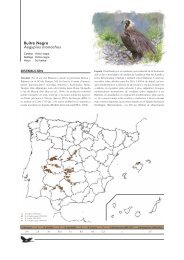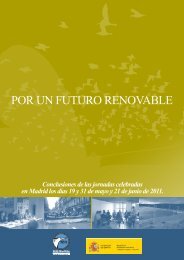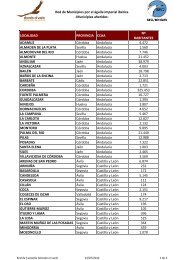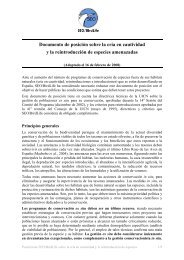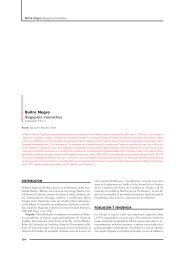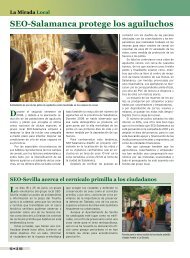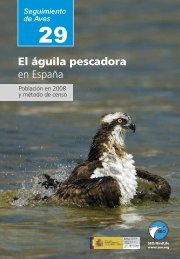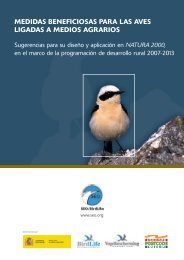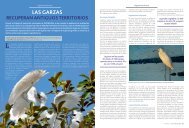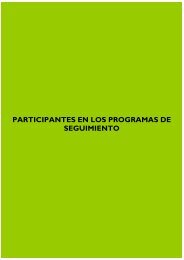La avutarda hubara - SEO/BirdLife
La avutarda hubara - SEO/BirdLife
La avutarda hubara - SEO/BirdLife
Create successful ePaper yourself
Turn your PDF publications into a flip-book with our unique Google optimized e-Paper software.
The Houbara Bustard in Spain<br />
Such a population increase is seen especially in <strong>La</strong>nzarote, whilst the populations<br />
of <strong>La</strong> Graciosa and Fuerteventura are fairly stable. In all cases, the density<br />
records for the four recent counts have always been higher than the December<br />
1994 estimates, and can be considered as the highest density values throughout<br />
the whole range for the species. Among the three main islands, the highest average<br />
density is obtained for the populations in <strong>La</strong>nzarote (5,08 individuals/km 2 ),<br />
as opposed to those of Fuerteventura (1,49) and <strong>La</strong> Graciosa (1,09).<br />
The population increase mentioned is different for each of the islands where the<br />
species is present. The results show the highest abundance of Houbara Bustards<br />
in <strong>La</strong>nzarote; a population increase during the LIFE Nature project period<br />
(2003-2007) has also occurred in this island, in particular from July 2005<br />
onwards, whilst this has not been observed in the remaining islands and islets.<br />
As compared to the 1994 census, Houbara Bustard densities were in all cases<br />
lower in those years than in the four recent counts in <strong>La</strong>nzarote, whilst recent<br />
values for <strong>La</strong> Graciosa and Fuerteventura are similar to past ones.<br />
By habitat type, the ‘jable’(large white sand areas) is the one hosting the highest<br />
number of individuals amongst the three types preferred by the species (i.e.<br />
white sands, bare and stony plains and, at unfavourable periods, marginal areas<br />
such as cropland borders). However, usage patterns are different for the various<br />
islands and islets. As regards the trends for the Houbara Bustard habitat, it<br />
should be noted that the rate between primary and secondary habitats has not<br />
been constant throughout the decade between the mid-1990 and the dates of<br />
the present census results. In fact, the primary habitats for the species have<br />
undergone an intense transformation, with the surface of secondary habitats<br />
having increased since 1994 largely as a result of land use changes and the<br />
impact of other human activities.<br />
According to the census results, the population estimates are 11-17 individuals<br />
in <strong>La</strong> Graciosa, 383-806 in <strong>La</strong>nzarote and 384-459 in Fuerteventura. After considering<br />
each of the four counts undertaken separately, the population of Houbara<br />
Bustard in the Canaries is 853-1.207 individuals; however, when the extreme<br />
values of each island are taken into account independently, the global population<br />
estimate shifts to 778-1.282 individuals for the reference period. Besides, the<br />
average population of Houbara Bustard after considering the four censuses altogether<br />
is 1.074,50 (±153,39).<br />
70



